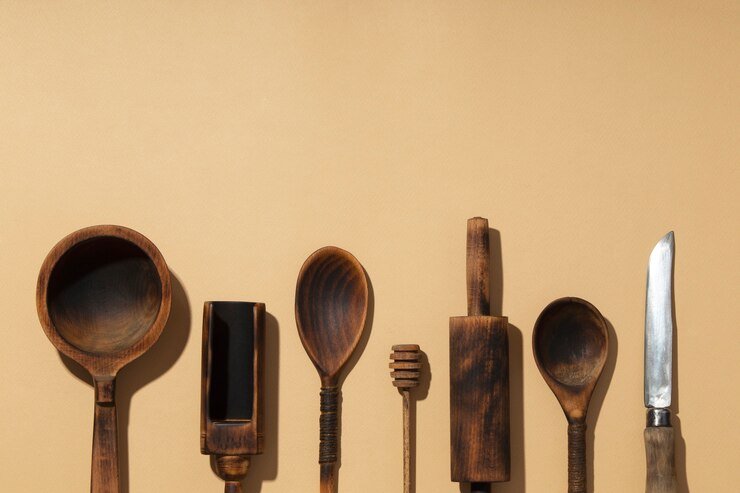More Than Just a Spoon
Think about the last time you stirred a pot of soup. Did you reach for a shiny stainless-steel ladle, or maybe a silicone spatula? Now imagine your grandmother or her grandmother standing by a fire centuries ago, stirring stew with nothing more than a wooden spoon.
The history of wooden spoon use in European kitchens stretches back thousands of years. It isn’t just about practicality; it’s about heritage, memory, and culture. Wooden spoons have stirred peasant soups in medieval cottages, mixed dough for holiday breads in French villages, and sat at the center of rituals, punishments, and even folklore. Surprisingly, they’re still with us today, despite the rise of modern materials.
Why did Europeans hold onto wooden spoons for so long? And what do these simple tools reveal about cooking, tradition, and family life? Let’s explore the story behind one of the humblest, yet most enduring, kitchen companions.
Why This Topic Matters
When you step back, it feels like talking about wooden spoons is talking about something bigger. These tools are part of our human connection to food. Every culture developed spoons, but in Europe, wooden ones took on a symbolic weight. They weren’t just utensils; they represented family, discipline, and even identity.
Understanding the history of wooden spoon traditions reminds us that cooking is not only about eating. It’s about storytelling, craftsmanship, and carrying small rituals from one generation to the next.
Ancient Roots: Where the Wooden Spoon Began
Archaeological evidence shows that spoons—made of bone, horn, and wood—have been around for at least 5,000 years. In prehistoric Europe, early spoons were carved from branches or animal bones. But by the Bronze and Iron Ages, wood became the preferred material for cooking utensils.
Why wood? Because it was abundant, easy to shape, didn’t transfer heat, and didn’t react with food. For peasants and nobility alike, the wooden spoon was practical and symbolic.
By the Middle Ages, wooden spoons were everywhere—from castles to cottages. Many were hand-carved by local craftsmen or even family members. A wooden spoon could be plain and functional, or beautifully decorated, depending on who owned it.
Wooden Spoons in European Culture
The beauty of the wooden spoon tradition is how it weaves through daily life, superstition, and even social order.
The Peasant’s Companion
For centuries, wooden spoons were tied to simple, hearty foods—porridge, stews, and broths. A single spoon might serve an entire family, passed from hand to hand at mealtime. In fact, in many poor households, spoons were so personal that each family member had their own, often carried on a belt.
The Symbol of Love
In Wales, the tradition of “love spoons” began in the 17th century. Young men carved ornate wooden spoons as tokens of affection for women they hoped to marry. Each design had meaning: a heart for love, a wheel for support, a keyhole for home. Some of these spoons still survive as works of art and cultural pride.
The Spoon as Discipline
Not every spoon memory was sweet. In many European households, the wooden spoon doubled as a tool of discipline. Parents used it as a quick way to scold misbehaving children. Generations later, people still joke about the “fear of the wooden spoon.”
Folk Traditions and Rituals
In some Eastern European countries, spoons had ritual value. They were used in religious feasts, communal meals, and seasonal festivals. Breaking bread with a wooden spoon was sometimes a sign of peace or unity.
Wooden vs. Modern: What’s the Difference?
To see why wooden spoons lasted so long in Europe, it helps to compare them with modern kitchen utensils.
| Feature / Benefit | Wooden Spoons (Tradition) | Modern Spoons (Steel/Plastic) |
|---|---|---|
| Heat Resistance | Won’t conduct heat—safe to touch | Metal heats up, plastic may melt |
| Food Safety | Won’t scratch pots, non-reactive | Metal reacts with acids, and plastic may leach |
| Durability | Long-lasting if cared for | Steel lasts longer, and plastic often breaks |
| Cultural Value | Deeply tied to family & heritage | Practical, but less symbolic |
| Environmental Impact | Biodegradable, sustainable | Steel is recyclable, but plastic pollutes |
Here’s what this really means: wooden spoons weren’t just “old-fashioned”, they were better suited for the slow, hearty cooking styles of European kitchens.
My Personal Connection
I still remember visiting my grandmother in her small countryside kitchen. She had drawers full of stainless-steel tools, but whenever she cooked her Sunday soup, she used a wooden spoon worn smooth with age. “Steel makes it taste different,” she’d say, though maybe it was more about memory than flavor.
One day, I tried stirring her recipe with a modern silicone spatula. The result? The soup was fine, but it didn’t feel the same. That spoon had absorbed years of meals, carrying a flavor and nostalgia no gadget could match.
Historical References and Expert Views
The Smithsonian has documented spoon traditions across the world, noting how wooden spoons in Europe became cultural artifacts, not just tools. History.com highlights their use in medieval kitchens, where they were as essential as cauldrons or hearths.
Ethnographic studies from European museums also show how spoon-making was tied to local craftsmanship. In rural areas, carving spoons was a winter pastime for men, who passed the skill down to their sons. The resulting spoons weren’t just functional; they were a sign of pride and artistry.
Even today, wooden spoons appear in museum collections, celebrated as both art and history.
Wooden Spoon Traditions by Region
Europe’s wooden spoon traditions vary widely, showing just how versatile and symbolic this tool became.
-
Wales: Love spoons carved as tokens of affection, a custom that still survives.
-
Scandinavia: Intricately carved spoons, often part of dowries or communal feasts.
-
Eastern Europe: Large communal spoons used in monasteries and peasant villages, symbolizing unity.
-
Mediterranean Europe: Wooden spoons tied to rustic cooking—stirring olive oil-based stews or tomato sauces over open fires.
-
Germany and Austria: Spoons often decorated with folk symbols, passed down through families as heirlooms.
Each region made the spoon its own, but all treated it as more than just a cooking stick.
Why Wooden Spoons Still Matter
In an age of non-stick pans and heat-resistant silicone, why do wooden spoons still hold value?
-
They’re gentle: won’t scratch pots, perfect for cast iron and clay cookware.
-
They’re natural: no chemicals, no coatings.
-
They’re emotional: they connect us to memories of grandparents, family recipes, and shared meals.
-
They’re cultural: love spoons, folk art, and storytelling keep them alive.
When you step back, it feels like wooden spoons are proof that the simplest tools often last the longest.
FAQs: History of Wooden Spoon
Q1: When were wooden spoons first used in Europe?
Wooden spoons have been found dating back thousands of years, with widespread use during the Bronze Age and Middle Ages.
Q2: Why were wooden spoons so common in Europe?
Wood was abundant, easy to carve, non-reactive with food, and safe for cooking over fire.
Q3: What’s the significance of Welsh love spoons?
They were hand-carved tokens of love and courtship, often passed down as keepsakes.
Q4: Do people still use wooden spoons today?
Yes, many cooks prefer them for stirring soups, sauces, and stews, especially in traditional kitchens.
Final Thoughts: More Than a Piece of Wood
The history of wooden spoon use in European kitchens reminds us that food is never just about ingredients—it’s about the tools, the rituals, and the people behind them.
When you stir soup with a wooden spoon, you’re not just cooking. You’re holding a piece of history, one that ties you to generations of cooks who came before. From love spoons in Wales to family heirlooms in Germany, these tools show us that simplicity can carry centuries of meaning.
Here’s what this really means: modern tools may save us time, but they can’t stir the soul the way a wooden spoon can.



